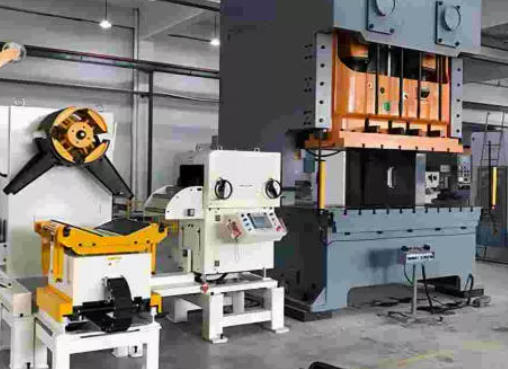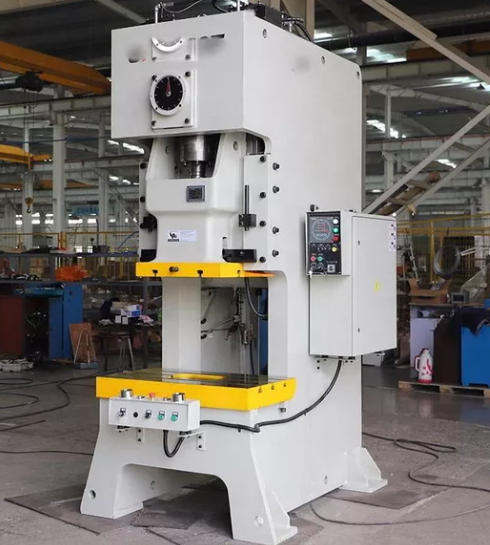Views: 222 Author: Rebecca Publish Time: 2025-11-19 Origin: Site









Content Menu
● Introduction: The Punch Press in Kitchenware Manufacturing
● Manual vs. Automatic Punch Presses: The Basics
>> What Is a Manual Punch Press?
>> What Is an Automatic Punch Press?
● Key Decision Factors in Choosing a Punch Press Machine
>> 2. Product Complexity and Customization
>>> Manual Press: Flexible But Labor-Intensive
>>> Automatic Press: Efficient but Less Adaptable
>> 3. Labor Availability and Costs
>> 4. Equipment Investment, Maintenance, and Space
>>> Manual Presses
>> 5. Quality Control and Consistency
>> 6. Downtime, Productivity, and Workflow Integration
● Technical Specifications and Machine Types
>> Servo-Electric Punch Presses
● Components and Features of Modern Punch Press Machines
>> Automatic Feeding and Finishing
● Workflow Integration in Kitchenware Factories
● Applications in Kitchenware Manufacturing
● Sustainability and Efficiency
● Maintenance and Operator Training
● Future Trends: Smart Manufacturing and the Internet of Things (IoT)
● Checklist: How to Choose Your Punch Press
● FAQ
>> 1. What types of kitchenware are best produced with manual punch presses?
>> 2. How much can automation reduce labor costs in punch press operations?
>> 3. Is it possible to automate complex kitchen utensil designs?
>> 4. What safety measures are necessary for manual and automatic punch presses?
>> 5. How should a kitchenware factory calculate the ROI of upgrading to automatic punch presses?
Choosing the right punch press machine is a critical decision for kitchenware manufacturers. In today's highly competitive cookware market, balancing cost, efficiency, product quality, and flexibility can make or break a factory's profitability. The choice between manual and automatic punch presses directly affects production output, labor needs, customization abilities, and long-term business growth. This article provides a comprehensive guide tailored to kitchen utensil and cookware plant managers, engineers, and procurement specialists looking to make the smartest punch press investment.

Punch press machines play a pivotal role in the molding, cutting, and forming of stainless steel and aluminum kitchenware. Products such as pots, pans, cutlery, sieves, and metal lids all pass through various stages of stamping and punching. Selecting the right machine not only impacts operational efficiency but also determines the feasibility of producing complex, premium, or customized kitchenware for different market segments.
A manual punch press operates by human intervention. The operator manually loads workpieces, aligns material, and activates the press, either with a hand lever or foot pedal. These machines are reliable, relatively simple, and have low upfront costs.
Manual punch presses are commonly used for:
- Small batch kitchenware production.
- Prototyping and product development for new utensils.
- Low to moderate stamping force requirements.
- Operations where flexibility and frequent retooling are required.
An automatic punch press uses advanced controls—sometimes CNC (Computer Numerical Control)—to coordinate feeding, alignment, pressing, ejection, and even stacking of finished parts. Little to no operator intervention is required after setup.
Automatic punch presses are widely adopted in:
- Mass production of kitchen utensils and cookware components.
- High-speed, repetitive operations.
- Environments demanding consistent quality and precision.
- Large-scale factories focused on cost per part reduction.
Manual stamping is optimal for small to medium quantities, custom designs, and R&D. For kitchenware such as limited edition pots, cutlery prototypes, or specialty utensils, manual presses provide essential flexibility.
Automatic machines shine in mass production. If your factory produces tens of thousands of identical frying pans, rice cooker lids, or flatware sets per month, automation will maximize your throughput and minimize labor costs.
Kitchenware industry rule of thumb:
If consistent production exceeds 1,000 parts per day, automatic punch presses become cost-effective over time.
Manual presses allow quick die changes and adjustments. When producing complex, multi-variant kitchenware—like designer spatulas or spatula heads with unique cutouts—manual setups offer superior adaptability.
Automatic presses excel with standardized SKUs but may require expensive reprogramming or custom feeds for new or niche items. For highly customized product lines, hybrid solutions might be needed.
- Manual: Skilled operators are necessary for safety and efficiency. Labor costs scale linearly with production volume.
- Automatic: Operators are only required for setup, monitoring, and troubleshooting, slashing labor hours per output significantly.
Rising labor costs, especially in developed regions, push larger manufacturers toward automation. Smaller or artisanal cookware brands, focusing on craftsmanship, may still value the manual approach.
- Lower upfront investment.
- Simpler maintenance.
- Minimal space requirements.
- Spare parts are affordable and widely available.
- Higher upfront and installation costs.
- Require expert maintenance and operator training.
- Consume more space due to integrated feeding and stacking systems.
- Longer ROI period but greater overall cost savings with high production.
- Manual Press: Variations depend on operator skill. Ideal for high-mix, low-volume manufacturing.
- Automatic Press: Consistency is built-in by design. Quality fluctuations are minimized, making it perfect for premium kitchenware brands demanding flawless finishes.
- Manual machines may face more downtime due to loading, setup changes, and human fatigue.
- Automatic machines support continuous operation and easier integration into interconnected production lines or smart factories, maximizing productivity.
- Manual presses require rigorous safety training; accidents due to operator error are a risk.
- Automatic presses, particularly with modern light curtains and sensors, enhance workplace safety by minimizing direct human-machine interaction.

Mechanical punch presses use motors, flywheels, gears, and cranks to deliver force. They are ideal for high-volume blanking, shallow forming, and rapid cycles. These presses can achieve speeds of up to 1,700 strokes per minute and offer stroke accuracy of ±0.05–±0.1 mm, making them suitable for standard kitchenware production.[1][5]
Hydraulic presses provide adjustable tonnage and smooth, controlled pressure. They excel at deep-drawing operations and shaping thicker metals, such as pot bodies or multi-layer trays. Hydraulic models can handle pressures up to 2,000 tons and are preferred for heavy-duty kitchenware components.[5][1]
CNC turret presses are programmable and accommodate frequent tooling changes. They support complex patterns within a single setup and are ideal for custom or small-batch runs. Turrets can hold 16 to 24 tools, enabling rapid adaptation for diverse kitchenware designs.[8][1]
Servo-electric presses use direct-drive motors for cleaner, quieter, and energy-efficient operations. They can reduce energy consumption by up to 50% compared to hydraulic models and are capable of speeds up to 1,500 strokes per minute. These presses are best for mass production environments where efficiency and sustainability are priorities.[1]
Modern punch presses feature sturdy steel construction and balanced frames to ensure consistent, vibration-free performance. C-frame (door frame) and H-frame (straight column) designs are common, with C-frames supporting up to 300 tons and H-frames handling higher pressures for thicker components.[6][1]
Advanced control panels and safety features regulate movement and force, ensuring precision and operator safety. Brakes and emergency stops prevent accidents, while tool monitoring sensors track wear and machine performance to minimize downtime.[6][1]
Interchangeable die sets offer flexibility for various product shapes, sizes, and branding needs. Turret systems allow for rapid tool changes, supporting diverse design requirements and reducing setup time.[8][1]
Robotic loaders and part stackers integrate seamlessly with automatic presses, facilitating uninterrupted production lines. In-line deburring, polishing, and edge finishing eliminate manual post-processing, further boosting efficiency.[1]
Modern kitchenware factories utilize a stepwise workflow to ensure efficient and quality-oriented production:
1. Sheet Metal Feeding: Automated systems load metal coils or sheets onto the worktable, minimizing manual handling.
2. Punching & Forming: The press applies force for blanking, piercing, and forming as per programmed patterns.
3. Finishing: Robotic in-line deburring, polishing, and edge finishing eliminate manual post-processing.
4. Quality Inspection: Integrated sensors and vision systems check dimensions and defects in real-time.
5. Packing: Automated sorters and stackers organize finished parts for packaging and shipment.[1]
Punch presses are fundamental in producing:
- Cutlery: Spoons, forks, and knives, manufactured rapidly and to precise specifications.
- Cookware Bodies: Pots, pans, lids, and trays, shaped and cut with minimal waste.
- Decorative Componentry: Embossed patterns and branded logos for premium kitchen products.
- Accessories: Food-safe containers, specialty cooking tools, and custom-designed utensils.[2][1]
Modern punch presses contribute to sustainable manufacturing through:
- Reduced Material Waste: Precision punching minimizes trim and reject rates.
- Lower Energy Use: Servo motors and regenerative braking systems cut consumption.
- Cleaner Operations: Enclosed systems and eco-friendly lubricants reduce pollution and support regulatory compliance.[1]
Routine lubrication, calibration, and preventive inspections keep machines running smoothly. Up-to-date operator training and regular tool monitoring are essential for consistent performance and safety.[5][1]
Increasingly, kitchenware plants are integrating punch presses (especially automatic models) with IoT platforms for:
- Real-time data analytics on machine health and production rates.
- Predictive maintenance reducing unexpected breakdowns.
- Automated scheduling and order tracking.
The next decade will likely see further convergence of robotics and artificial intelligence with traditional metalworking, further tipping the scales toward automation.
Use the following checklist to evaluate your needs:
- What is the typical and maximum order volume per SKU?
- Do products require frequent design changes or custom features?
- What are the labor costs in your region or factory?
- How much floorspace is allocated for punch press operations?
- What levels of repeatability and precision do your customers expect?
- Is there a long-term plan for automating other production steps?
- What is the target ROI period for your machinery investment?
Discussing these questions with your engineering, production, and finance teams will help pinpoint the best-fit solution.
Choosing between a manual and automatic punch press is about striking the right balance between flexibility, efficiency, investment, and long-term growth. For kitchenware manufacturers dealing with diverse and ever-changing market demands, manual presses offer adjustability and faster R&D cycles. For high-volume producers focused on labor savings and quality control, automatic punch presses deliver maximum value. Ultimately, the best choice stems from clear analysis of your product portfolio, growth ambitions, and available resources. As the industry adopts more automation and smart manufacturing practices, careful planning now will ensure a sustainable and profitable future.

Manual punch presses are best for specialized kitchen tools, small production runs, product prototypes, and items with frequent design changes. Examples include custom-engraved spatulas, utensils for new market testing, or limited edition cookware sets.
Automation can reduce punch press labor hours by 60-80% in mass production environments, especially when machines operate across multiple shifts. The upfront investment is higher, but savings accrue rapidly with increased output.
Yes, but automation works best for repeatable, standardized parts. For complex, multi-step utensils, custom dies and advanced CNC programming may be needed, increasing costs and setup time. Hybrid methods—using both manual and automated processes—are often most effective for intricate products.
Manual presses require strict operator training, use of guards, and frequent safety audits to prevent accidents. Automatic presses should have light curtains, emergency stops, and regular maintenance checks. Automation also removes operators from hazardous zones, reducing injury risk.
ROI should be calculated by comparing total labor savings, productivity improvements, reduced scrap rates, potential for increased sales, and machine depreciation. Include expenses for installation, training, and machine maintenance over the expected lifecycle.
Why The Right Punch Press Machine Is Crucial for High-Quality Tableware Production?
Punch Press Machines: The Backbone of Efficient Cutlery Production
How To Choose Between Manual And Automatic Punch Press Machines?
Best Punch Press Machines for Small And Large-Scale Manufacturers
Top Manufacturers of Punch Press Machines for The Tableware Industry
What Are The Key Benefits of Investing in A Punch Press Machine for Your Factory?
How Punch Press Machines Are Revolutionizing The Cutlery Industry?
The Role of Punch Press Machines in Modern Kitchenware Production Lines
Punch Press Machine Vs. Turret Punch Press: What's The Difference?
